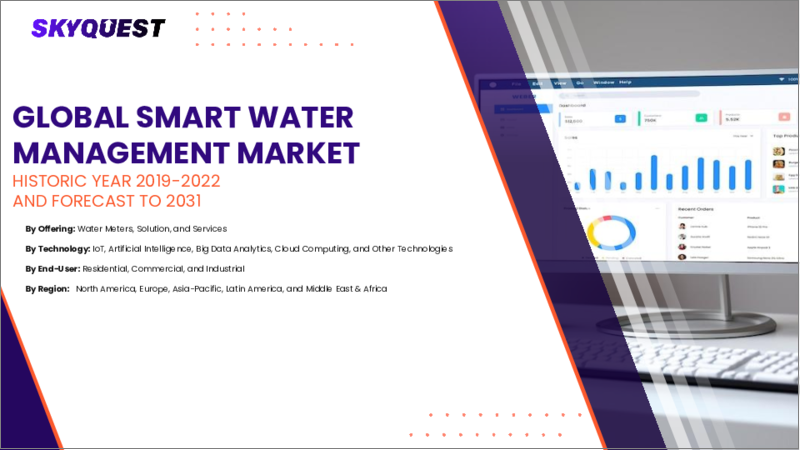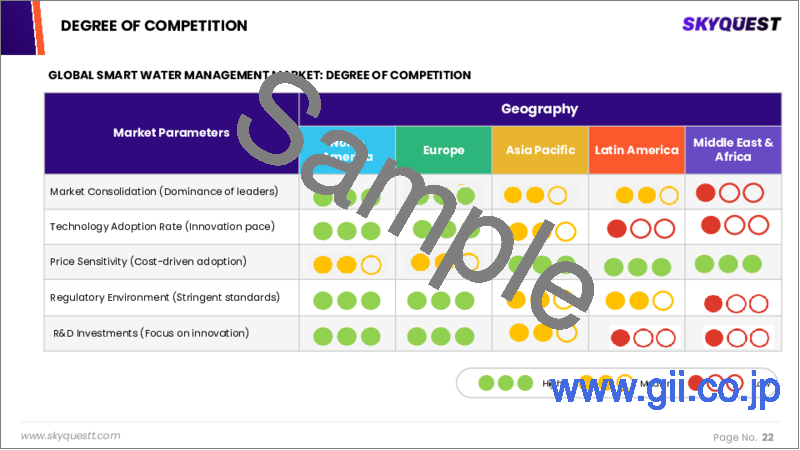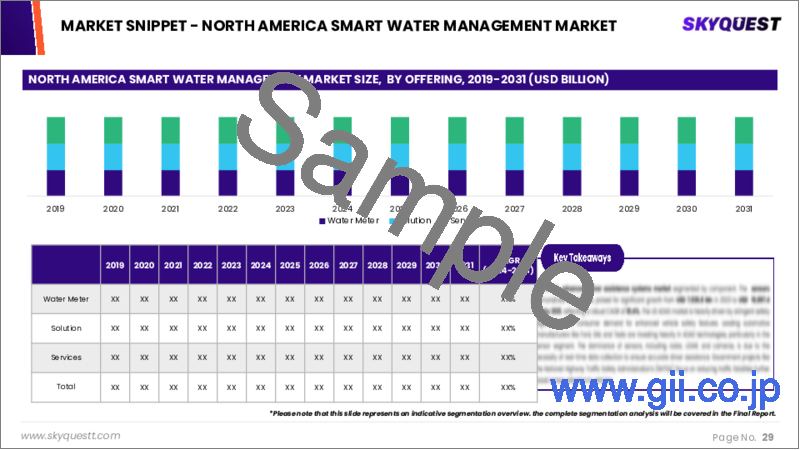|
|
市場調査レポート
商品コード
1596916
スマート水管理の市場規模、シェア、成長分析、オファリング別、技術別、エンドユーザー別、地域別 - 産業予測、2024年~2031年Smart Water Management Market Size, Share, Growth Analysis, By Offering (water meters, solutions), By Technology (IoT, Artificial Intelligence), By End User (Residential, Commercial), By Region - Industry Forecast 2024-2031 |
||||||
|
|||||||
| スマート水管理の市場規模、シェア、成長分析、オファリング別、技術別、エンドユーザー別、地域別 - 産業予測、2024年~2031年 |
|
出版日: 2024年11月17日
発行: SkyQuest
ページ情報: 英文 242 Pages
納期: 3~5営業日
|
全表示
- 概要
- 目次
スマート水管理の世界市場規模は、2022年に149億1,000万米ドルと評価され、2023年の166億米ドルから2031年には390億9,000万米ドルに成長し、予測期間中(2024-2031年)のCAGRは11.3%で成長する見通しです。
スマート水管理(SWM)は、都市の水使用量と水質の監視、制御、規制を最適化するために設計された革新的なシステムであり、世界的に政府や企業の間で支持を集めています。センサー、水道メーター、分析ツールなどの先進技術を採用し、廃棄物を最小限に抑え、エネルギー消費を合理化します。SWMは、節水努力への消費者の関与を強化することで、漏水検知に関連するコストを大幅に削減し、公共事業における水の汲み上げに必要なエネルギーを低減します。このテクノロジーは、ネットワークの課題を特定し、利用者により一層の節約を促し、インフラの老朽化に関連した無収水損失という重大な問題に取り組む能力を組織に提供します。水圧、流量、配水に関する重要なデータを収集し、水輸送インフラとエネルギーの効率的な管理に不可欠です。SWMの主な特徴は、情報通信技術(ICT)を統合することであり、水管理のさまざまな課題に対処するためのデータ主導型の洞察をリアルタイムで提供します。スマートシステムの多用途性は、洪水管理、干ばつ対応、漏水検知、圧力調整、効果的な灌漑慣行、水質・水量の維持など、その応用範囲の広さからも明らかです。自治体や組織は、資源を効率的に配分しなければならないというプレッシャーに直面しており、スマート水管理テクノロジーの採用は、持続可能な水管理戦略における重要な進歩を意味します。
目次
イントロダクション
- 調査の目的
- 調査範囲
- 定義
調査手法
- 情報調達
- 二次データと一次データの方法
- 市場規模予測
- 市場の前提条件と制限
エグゼクティブサマリー
- 世界市場の見通し
- 供給と需要の動向分析
- セグメント別機会分析
市場力学と見通し
- 市場概要
- 市場規模
- 市場力学
- 促進要因と機会
- 抑制要因と課題
- ポーター分析と影響
- 競争企業間の敵対関係
- 代替品の脅威
- 買い手の交渉力
- 新規参入業者の脅威
- 供給企業の交渉力
主な市場の考察
- 重要成功要因
- 競合の程度
- 主な投資機会
- 市場エコシステム
- PESTEL分析
- マクロ経済指標
- 市場の魅力指数
- バリューチェーン分析
- 特許分析
- ケーススタディ分析
- 価格分析
- 技術分析
- 規制分析
スマート水管理の市場規模:オファリング別
- 市場概要
- 水道メーター
- Amrメーター
- Amiメーター
- ソリューション
- エンタープライズ資産管理
- 分析とデータ管理
- セキュリティ
- スマート灌漑管理
- 高度な圧力管理
- モバイルワークフォース管理
- ネットワーク管理
- 顧客情報システムと請求
- 漏れ検出
- その他のソリューション
- サービス
- プロフェッショナルサービス
- マネージドサービス
スマート水管理の市場規模:技術別
- 市場概要
- IoT
- 人工知能
- ビッグデータと分析
- クラウドコンピューティング
- その他の技術
スマート水管理の市場規模:エンドユーザー別
- 市場概要
- 住宅
- 商業
- 産業
- 製造業
- エネルギー・公益事業
- 農業
- 鉱業
- その他
スマート水管理の市場規模:地域別
- 北米
- 米国
- カナダ
- 欧州
- 英国
- ドイツ
- スペイン
- フランス
- イタリア
- その他欧州地域
- アジア太平洋
- 中国
- インド
- 日本
- 韓国
- その他アジア太平洋地域
- ラテンアメリカ
- ブラジル
- その他ラテンアメリカ地域
- 中東およびアフリカ
- GCC諸国
- 南アフリカ
- その他中東・アフリカ
競合情報
- 上位5社の比較
- 主要企業の市場ポジショニング(2023年)
- 主な市場企業が採用した戦略
- 市場の最近の動向
- 企業の市場シェア分析(2023年)
- 主要企業の企業プロファイル
- 会社概要
- 製品ポートフォリオ分析
- セグメント別シェア分析
- 収益の前年比比較(2021-2023)
主要企業プロファイル
- Siemens(Germany)
- IBM(US)
- ABB(Switzerland)
- Honeywell Elster(US)
- Schneider Electric(France)
- Itron(US)
- SUEZ(France)
- Oracle(US)
- Landis+Gyr(Switzerland)
- Trimble Water(US)
- Xylem(US)
- Kamstrup(Denmark)
- HydroPoint(US)
- i20(UK)
- Xenius(India)
- Neptune Technology(US)
- TaKaDu(Israel)
- Badger Meter(US)
- AquamatiX(UK)
- Lishtot(Israel)
結論と推奨事項
Global Smart Water Management Market size was valued at USD 14.91 billion in 2022 and is poised to grow from USD 16.60 billion in 2023 to USD 39.09 billion by 2031, growing at a CAGR of 11.3% during the forecast period (2024-2031).
Smart Water Management (SWM) is an innovative system designed to optimize the monitoring, controlling, and regulation of urban water usage and quality, gaining traction among governments and companies globally. It employs advanced technologies including sensors, water meters, and analytical tools to minimize waste and streamline energy consumption. By enhancing consumer engagement in conservation efforts, SWM significantly reduces costs associated with leak detection and lowers the energy required for water pumping at utilities. This technology equips organizations with the capability to identify network challenges, encourage greater conservation among users, and tackle the critical issue of non-revenue water loss linked to aging infrastructure. It collects vital data on water pressure, flow, and distribution, essential for the efficient management of water transport infrastructure and energy. A key feature of SWM is its integration of Information and Communication Technology (ICT), providing real-time data-driven insights to address various water management challenges. The versatility of smart systems is evident in their wide-ranging applications, including flood management, drought response, leak detection, pressure regulation, effective irrigation practices, and maintaining water quality and quantity. As municipalities and organizations face increasing pressure to allocate resources efficiently, the adoption of smart water management technology represents a critical advancement in sustainable water management strategies.
Top-down and bottom-up approaches were used to estimate and validate the size of the Global Smart Water Management market and to estimate the size of various other dependent submarkets. The research methodology used to estimate the market size includes the following details: The key players in the market were identified through secondary research, and their market shares in the respective regions were determined through primary and secondary research. This entire procedure includes the study of the annual and financial reports of the top market players and extensive interviews for key insights from industry leaders such as CEOs, VPs, directors, and marketing executives. All percentage shares split, and breakdowns were determined using secondary sources and verified through Primary sources. All possible parameters that affect the markets covered in this research study have been accounted for, viewed in extensive detail, verified through primary research, and analyzed to get the final quantitative and qualitative data.
Global Smart Water Management Market Segmental Analysis
North America dominated the Global Smart Water Management Market in 2021. This can be attributed to stronger government regulations and rising demand for clean energy options across the region. People in North American residential regions are starting to understand the advantages of all smart water management technologies, such as how they help to decrease water waste, enhance water quality, prevent leaks, and help control water use. Because of this, the market for smart water management is likely to develop as demand for these solutions rises in the North American region.
Driver of the Global Smart Water Management Market
The global smart water management market is being propelled by the urgent need to upgrade and replace obsolete water infrastructure. As municipalities grapple with aging systems that struggle to meet the rising demand for clean water, there is a growing imperative to address challenges in flood control, automated treatment, distribution, storage, and resource management. The increasing population, urbanization, and economic growth further exacerbate the pressure on water systems, with over 2 billion people affected by water scarcity and nearly half the world's population lacking safe sanitation. Smart technologies are now being adopted by water utilities to enhance operational efficiency, reduce maintenance costs, and ensure the delivery of high-quality water management services, thereby facilitating a more sustainable approach to utilizing precious water resources.
Restraints in the Global Smart Water Management Market
One of the significant obstacles facing the Global Smart Water Management market is the shortage of digitally skilled personnel within the water utilities sector. Additionally, there's a notable gap in awareness among younger generations regarding career opportunities in this field, which further inhibits market growth. Furthermore, the high initial expenditures associated with implementing advanced metering infrastructure (AMI) pose another challenge, as these systems require substantial upfront investment. Coupled with the extended payback periods associated with smart water technology deployment, these factors collectively hinder the advancement and expansion of the smart water management sector on a global scale.
Market Trends of the Global Smart Water Management Market
The Global Smart Water Management market is witnessing remarkable growth driven by increasing water scarcity and the adoption of advanced technologies such as 5G and IoT. As water utilities face immense pressure to optimize water distribution, they are turning towards integrated multi-partner systems that leverage these technologies, alongside Business Support Systems (BSS), to enhance monitoring, management, and monetization of water resources. This trend facilitates real-time data collection and analysis, leading to proactive management that minimizes water loss, improves supply efficiency, and fosters transparency in billing. Consequently, the market is poised for expansion as stakeholders prioritize sustainable water solutions amidst global challenges.
Table of Contents
Introduction
- Objectives of the Study
- Scope of the Report
- Definitions
Research Methodology
- Information Procurement
- Secondary & Primary Data Methods
- Market Size Estimation
- Market Assumptions & Limitations
Executive Summary
- Global Market Outlook
- Supply & Demand Trend Analysis
- Segmental Opportunity Analysis
Market Dynamics & Outlook
- Market Overview
- Market Size
- Market Dynamics
- Driver & Opportunities
- Restraints & Challenges
- Porters Analysis & Impact
- Competitive rivalry
- Threat of substitute
- Bargaining power of buyers
- Threat of new entrants
- Bargaining power of suppliers
Key Market Insights
- Key Success Factors
- Degree of Competition
- Top Investment Pockets
- Market Ecosystem
- PESTEL Analysis
- Macro-Economic Indicators
- Market Attractiveness Index
- Value Chain Analysis
- Patent Analysis
- Case Study Analysis
- Pricing Analysis
- Technology Analysis
- Regulatory Analysis
Global Smart Water Management Market Size by Offering & CAGR (2024-2031)
- Market Overview
- Water Meters
- Amr Meters
- Ami Meters
- Solutions
- Enterprise Asset Management
- Analytics & Data Management
- Security
- Smart Irrigation Management
- Advanced Pressure Management
- Mobile Workforce Management
- Network Management
- Customer Information System & Billing
- Leak Detection
- Other Solutions
- Services
- Professional Services
- Managed Services
Global Smart Water Management Market Size by Technology & CAGR (2024-2031)
- Market Overview
- IoT
- Artificial Intelligence
- Big Data & Analytics
- Cloud Computing
- Other Technologies
Global Smart Water Management Market Size by End User & CAGR (2024-2031)
- Market Overview
- Residential
- Commercial
- Industrial
- Manufacturing
- Energy & Utilities
- Agriculture
- Mining
- Others
Global Smart Water Management Market Size & CAGR (2024-2031)
- North America, (Offering, Technology, End User)
- US
- Canada
- Europe, (Offering, Technology, End User)
- UK
- Germany
- Spain
- France
- Italy
- Rest of Europe
- Asia-Pacific, (Offering, Technology, End User)
- China
- India
- Japan
- South Korea
- Rest of Asia Pacific
- Latin America, (Offering, Technology, End User)
- Brazil
- Rest of Latin America
- Middle East & Africa, (Offering, Technology, End User)
- GCC Countries
- South Africa
- Rest of Middle East & Africa
Competitive Intelligence
- Top 5 Player Comparison
- Market Positioning of Key Players, 2023
- Strategies Adopted by Key Market Players
- Recent Developments in the Market
- Company Market Share Analysis, 2023
- Company Profiles of All Key Players
- Company Details
- Product Portfolio Analysis
- Company's Segmental Share Analysis
- Revenue Y-O-Y Comparison (2021-2023)
Key Company Profiles
- Siemens (Germany)
- Company Overview
- Business Segment Overview
- Financial Updates
- Key Developments
- IBM (US)
- Company Overview
- Business Segment Overview
- Financial Updates
- Key Developments
- ABB (Switzerland)
- Company Overview
- Business Segment Overview
- Financial Updates
- Key Developments
- Honeywell Elster (US)
- Company Overview
- Business Segment Overview
- Financial Updates
- Key Developments
- Schneider Electric (France)
- Company Overview
- Business Segment Overview
- Financial Updates
- Key Developments
- Itron (US)
- Company Overview
- Business Segment Overview
- Financial Updates
- Key Developments
- SUEZ (France)
- Company Overview
- Business Segment Overview
- Financial Updates
- Key Developments
- Oracle (US)
- Company Overview
- Business Segment Overview
- Financial Updates
- Key Developments
- Landis+Gyr (Switzerland)
- Company Overview
- Business Segment Overview
- Financial Updates
- Key Developments
- Trimble Water (US)
- Company Overview
- Business Segment Overview
- Financial Updates
- Key Developments
- Xylem (US)
- Company Overview
- Business Segment Overview
- Financial Updates
- Key Developments
- Kamstrup (Denmark)
- Company Overview
- Business Segment Overview
- Financial Updates
- Key Developments
- HydroPoint (US)
- Company Overview
- Business Segment Overview
- Financial Updates
- Key Developments
- i20 (UK)
- Company Overview
- Business Segment Overview
- Financial Updates
- Key Developments
- Xenius (India)
- Company Overview
- Business Segment Overview
- Financial Updates
- Key Developments
- Neptune Technology (US)
- Company Overview
- Business Segment Overview
- Financial Updates
- Key Developments
- TaKaDu (Israel)
- Company Overview
- Business Segment Overview
- Financial Updates
- Key Developments
- Badger Meter (US)
- Company Overview
- Business Segment Overview
- Financial Updates
- Key Developments
- AquamatiX (UK)
- Company Overview
- Business Segment Overview
- Financial Updates
- Key Developments
- Lishtot (Israel)
- Company Overview
- Business Segment Overview
- Financial Updates
- Key Developments





